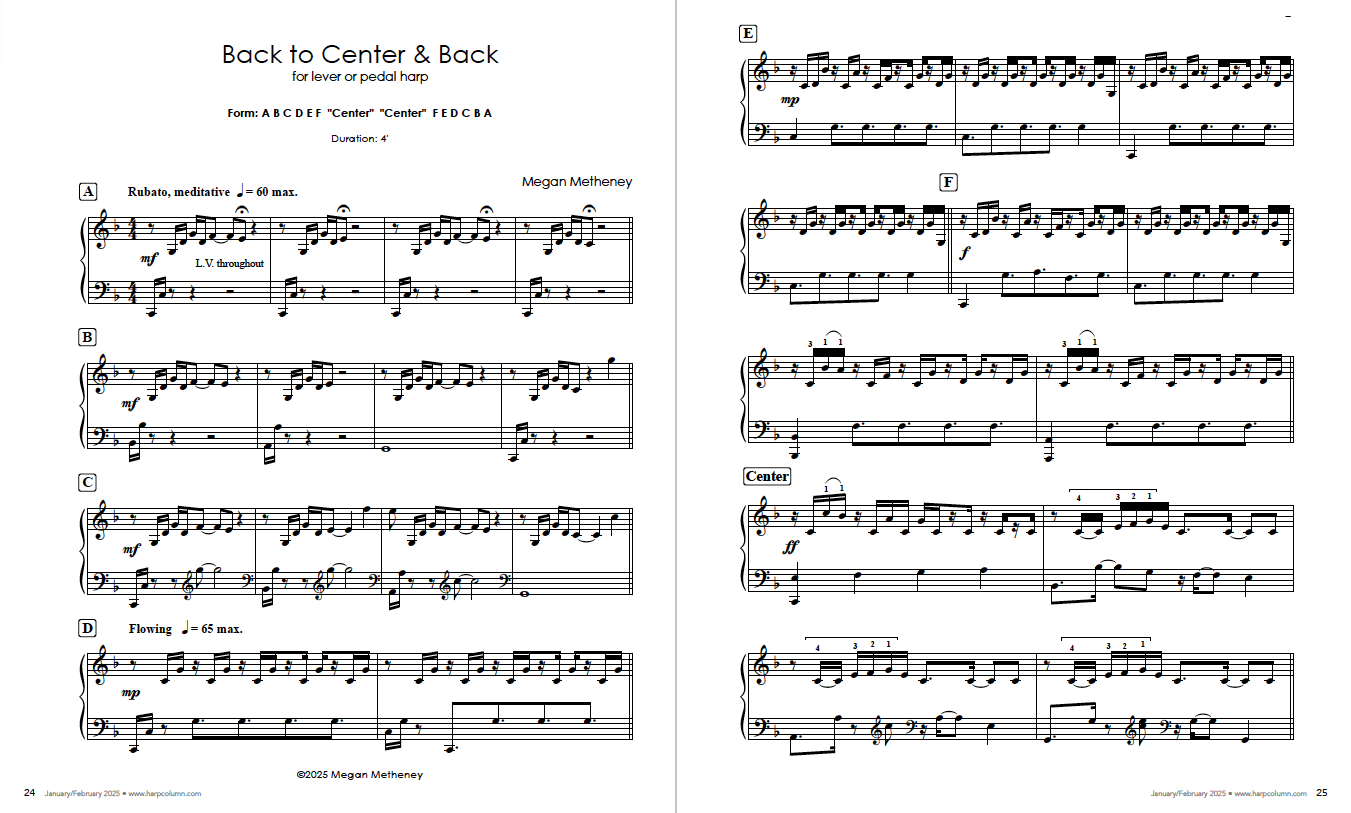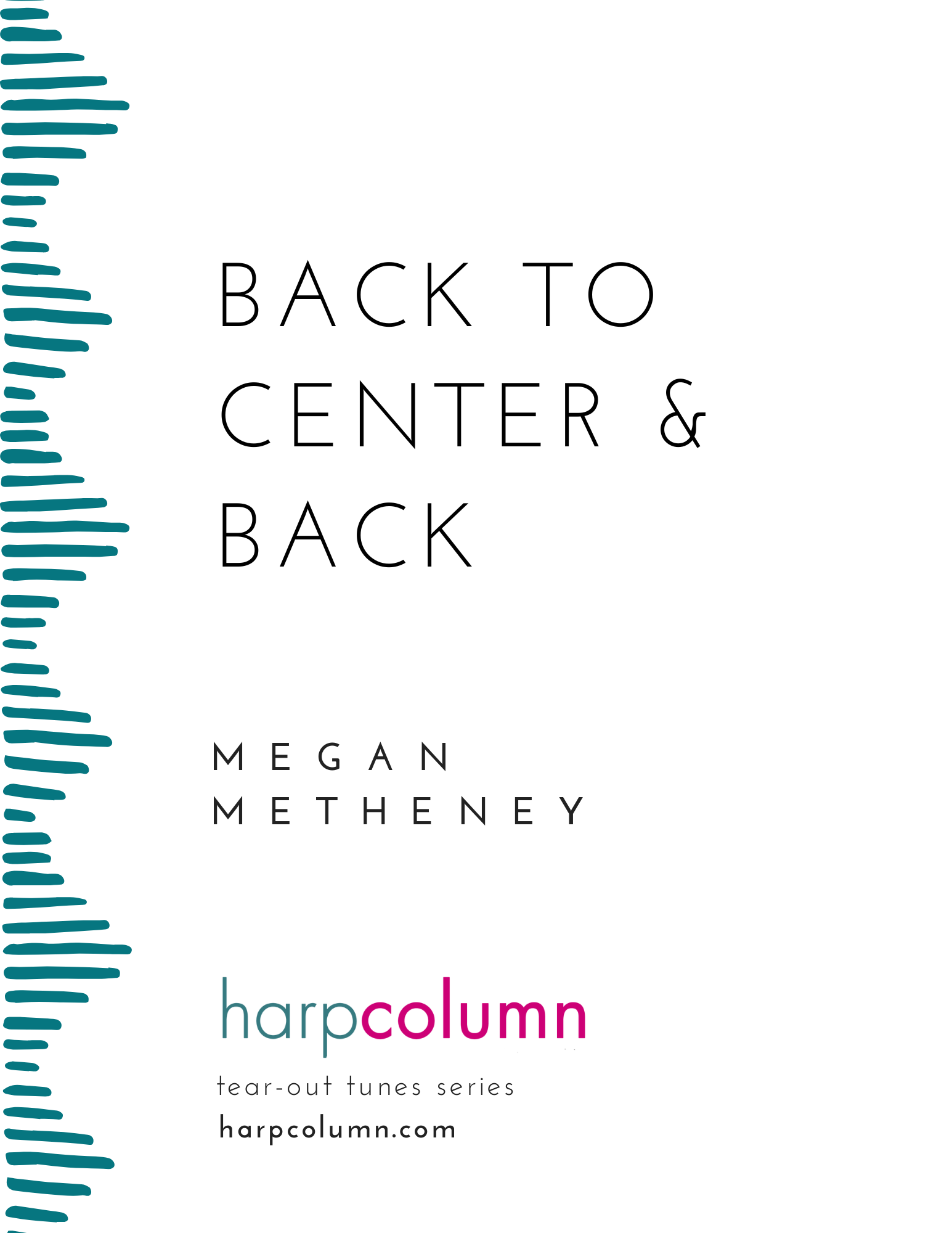
Download this issue to get this tune now!
Each installment of our Tear-Out Tunes series features a new piece written by one of the best harpist-composer-arrangers in the business. Each composer will tell you a little bit about their piece, and also give you some helpful tips for learning it and getting the most out of the experience. The new piece (on the following pages) is yours to keep. We even put it right in the middle of the magazine so you can tear out the whole sheet and put your new tune on your music stand.
Fellow harpists, bear with me here—this piece is a bit backwards! Let me explain.
Back to Center & Back is read and played as a normal piece, except that when you arrive at the end, you’ll play each section in backwards order, finishing where you started.
Playing this piece forward and backwards is like meditation with a twist. In meditation or a personal quiet time, the goal is often to go “into” a state of calmness and peacefulness, then to return to our busy world with a renewed focus.
My idea with this piece takes a different approach. It is a type of meditation or contemplation at the harp, but it doesn’t go from busy-minded to calm and concentrated. Instead, it starts with calm breath, graduates to an active “center,” then returns to calm breath. And the “center” section—hear me out—is the space where you, the harpist, are invited to simply be you, your colorful and vibrant self. You, the imperfect and beautiful creation that you are, who is living and breathing in this present moment.
It’s not a type of self-worship, don’t get me wrong. It’s an invitation to go back to your inner self, to touch base with who you are, to remember that you are unique, and, most of all, that you are important. You matter.
How the piece came to be
Just before leaving on a weekend retreat with church, I received an invitation from Alison Reese at Harp Column asking if I would be interested in composing a piece for the Tear-Out Tune series. My goodness, what an incredible honor!
There was free time scheduled at the retreat, and I knew right away that I wanted to use that time to sit down with my harp and get to work on the piece. The theme of the weekend was “listen.” I was eager to do just that, and I wanted to let the harp take part in the speaking.
When I sit down with the intention to compose, I try not to think too hard. I decide on a key. I improvise. I listen. This might seem odd, but I try to simply let the harp make its beautiful sound as if I’m a spectator to my fingers and the strings. I’m not just randomly plucking away, of course, but I consciously don’t focus on chord progressions or theory.
We know the treasure we have in our instrument. If a harp is in tune, it’s hard to make it sound bad. Sometimes improvisations are just nice, and other times we stumble upon something extra-amazing that we would want to hear again. And voila—improvisation has started to turn into composition.
I had read that F is a note that resonates with the heart, which seemed appropriate. F major it is then, and I set my levers accordingly. I started to improvise and to listen to what the harp was saying.
The key started to gravitate towards C Mixolydian instead of F. I stayed flexible to that, letting the improvisation flow, letting the improvisation flow…
Bon voyage
Back to Center & Back was created in one sitting. I’ve tweaked it here and there since, and test-drove it for a couple of months.
As we know, our mood and outlook are not the same day in and day out. During that weekend retreat and composing the piece, I was in a happy place: excited, stable, feeling good. It’s been interesting to experience how the piece has comforted me, though, on days when I’m feeling discouraged or down. It prompts me to remember that I am alive and a work in progress. Important. Again, that I matter.
As musicians, most of the time we learn a piece with the intention of performing it or sharing it with others. But sometimes we play for ourselves, am I right? Even as a type of therapy, allowing our own playing to nourish our soul. Music can comfort us, uplift us, and inspire us, and that’s what I hope this piece may do for you.
I envision Back to Center & Back not necessarily as a piece that belongs on stage. Of course it’s for you to learn and play in any situation you’d like, but I see it more as a piece for the harpist to enjoy by themselves, alone in the sacred practice room.
I must say, I still get an adrenaline rush when I’m playing the piece backwards! I hope you enjoy the same. Bon voyage on your way back to center and back. •
Technical notes
- Feel free to stay in the “center” for longer than just one repeat.
- The notation is harp-oriented. “Let vibrate throughout” is essential, which means that an eighth note, for example, will ring longer than what’s written on the page. This avoids the clutter of ties.
- Fingerings are quite personal, but I’ve included a few that I think help with sightreading.







